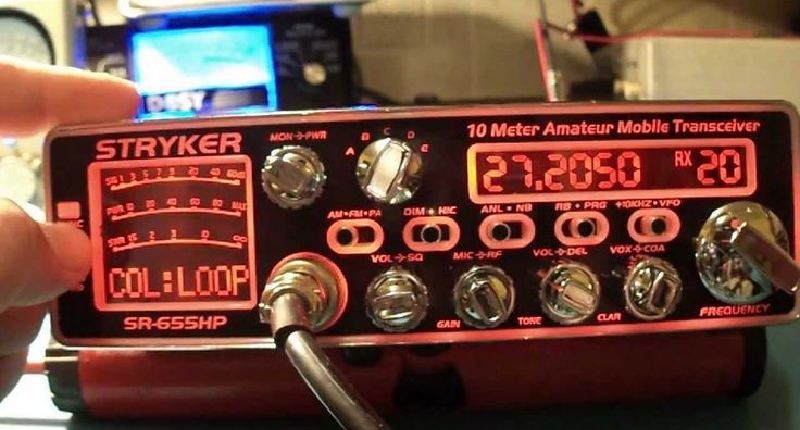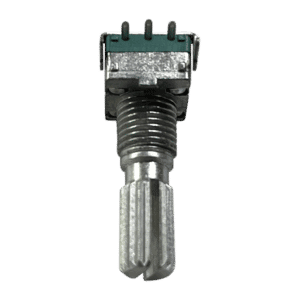Ham radio is an amateur radio system with a long and exciting history. There are over 700,000 ham radio operators in the U.S. and over 3 million around the world. Despite its name, ham radio is much more than a hobby. Ham operators have advanced the science of radio and electronics, provided emergency communications during countless disasters, and even worked with NASA.
If you’re interested in ham radio, you can begin with a modest setup and increase your investment of time and resources as your interest grows. There is more than enough going on in the field to keep your attention for a lifetime! This guide will explain just what being a ham operator entails, where to find resources for education and licensing, and how to pick the best ham radio for your setup.
Ham Radio Licensing
To use a ham radio, amateur radio operators are required by the Federal Communications Commission to obtain a license by passing an exam. There are three levels of licensing for ham operators with increasingly difficult qualifications. When you pass the exam, your new license will arrive in the mail along with your call sign.
- Technician Class: an entry-level license that grants transmitting privileges on the VHF and UHF bands used for local communication, and limited ham bands for global transmissions
- General Class: expands transmitting privileges to long-distance, international communication via signal propagation, and increased voice operation on ham bands
- Amateur Extra Class: provides access to the full range of ham bands allocated to the Amateur Radio Service
Many operators enjoy the capabilities of a technician’s license and don’t feel the need to apply for a higher-level license. For example, a growing number of people are moving from CB radios to 10-meter mobile radios in their vehicles. While CB radios have been a mainstay for long-haul truckers, these radios are limited to a range of about seven miles. A ham operator in the 10-meter band has access to more power and a range of about 50 miles.
How to Learn Ham Radio
While ham radio licenses are controlled by the FCC, the day-to-day management of amateur radio is handled by the American Radio Relay League (ARRL), a nationwide public service organization. The ARRL has members in every city and most towns, and they help amateur radio operators by providing the following services:
- Serve as volunteer examiners for amateur radio operator license exams.
- Make sure amateur radio operators are familiar with all of the regulatory guidelines related to radio communication.
- Provide study guides on the ARRL website.
- Hold classes to help amateur radio service applicants prepare for their license exam.
- Teach operators about the differences between radio technology like ham radios, FRS, GMRS, SDR, and CB radio.
- Help operators understand the radio spectrum, learn terminology such as “MHz”, “bandwidth”, and “repeaters”, and master communication methods like CW (for Morse Code) and PSK31 (for talking through computers).
- Connect amateur radio enthusiasts with local amateur radio clubs.
The ARRL is active on social media and has meetups (hamfests) on a regular basis. Hamfests are a great opportunity to meet people with similar interests and learn about the equipment they use. These events are invaluable if you are considering buying a more advanced radio or applying for a more advanced amateur radio license. In addition to meeting in person, operators can participate in fun on-the-air challenges like making the most contacts in a given time, making the most distant contact, or communicating with the International Space Station (ISS).
Why are they called “ham radio operators”?
The term “ham” came into common usage early on; it refers to amateur (ham-fisted) telegraph operators with poor skills. Shady telegraph schools were even called “ham factories”. After the number of amateur radio operators began to proliferate, the moniker stuck.
The Different Types of Ham Radio
Unlike a typical radio that can only receive broadcasts, ham radios are also transmitters. Instead of a radio receiver, ham operators use a transceiver, which both receives and transmits radio signals. Transceivers range in size from simple handheld radios to desktop base stations. Ham operators also have a network of satellites they use to boost the signal for radio communication.
If you’re not sure about your level of interest, handheld radios are the least expensive option and make a great point of entry. Because of their limited range and somewhat specialized use, handheld models only connect over short distances. If you want to communicate over a wider range, a mobile radio is a better choice. A mobile radio is cost-effective because it can be disconnected from the vehicle antenna and then used at home as a base station connected to a larger antenna. Base station models transmit over the longest distances and are the most complicated to use, so they’re typically not the best choice for ham radio hobbyists who are just starting out. Read on for more details about the types of ham radio.
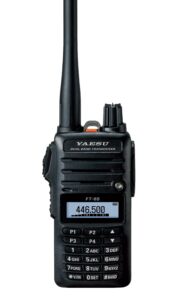
1. Handheld Radios
Handheld radios are easily portable and resemble large walkie-talkies. They have a short, rubber-covered antenna known as a “stubby” or “rubber ducky”. Handhelds are common at large public events, or in emergency situations when amateur radio service is needed for communication. Disaster situations wreak havoc on cell phone networks, either because everyone is trying to use their phone at once, or because power loss takes down the service. Because they run on batteries, handheld radios are ideal for emergency services. Even though the small antenna provides a limited range, the lower frequencies allow the signal to propagate farther than other radios could.
Handheld VHF/UHF Ham Radio, FT-65, from Yaesu (image: Yaesu.com)
2. Mobile Radios
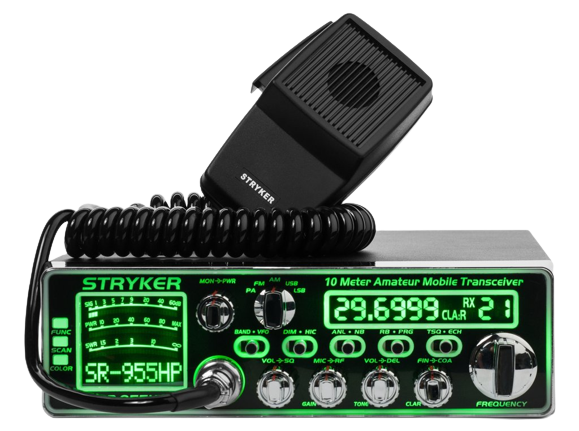
10-Meter Amateur Mobile Transceiver, SR-955HPC, from Stryker Radios
Mobile ham radios are the nearest equivalent to CB radios. These book-sized units are typically mounted under a dashboard in a vehicle. Their control interface is designed to be simple enough for beginning radio operators, and most importantly, for drivers. Mobile radios use handheld push-to-talk microphones and often operate specifically in the 10-meter band, where they’re tailored for use on the road. Mobile ham radios all have standard antenna jacks, and a variety of antennas can be used with them. This gives them a significantly longer range than other popular types of mobile radio. Mobile ham radios can transmit with up to 200 watts of power across the high-frequency band.
At Stryker Radios we’ve streamlined the user interface on our mobile radios to make them easier and safer to use in a vehicle. Stryker also makes antenna selection easy, with radio antennas and accessories that are ideal for mobile ham radios.
Why a Mobile Ham Radio for your Truck Makes Perfect Sense
3. Base Stations
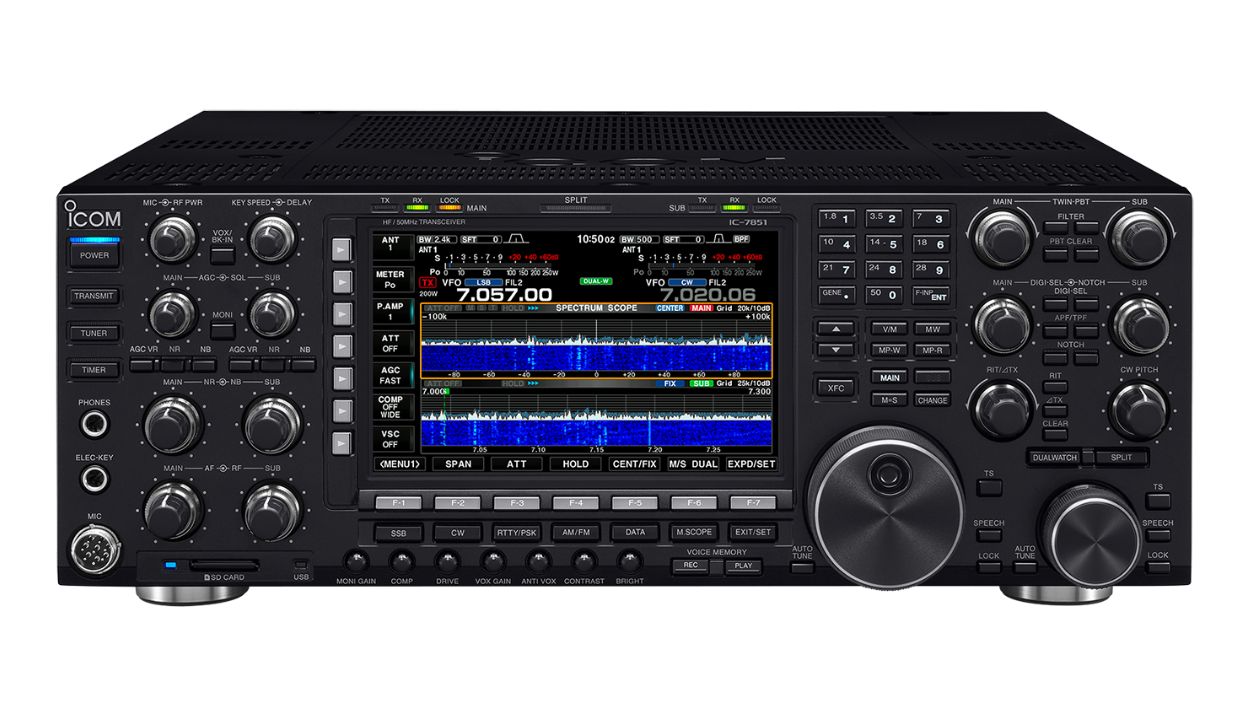 Base Station Ham Radio, IC-7851, from Icom (image: www.icomamerica.com)
Base Station Ham Radio, IC-7851, from Icom (image: www.icomamerica.com)
Base station radios are considerably larger than mobile radios and are installed in a stationary location. Because they provide communication in multiple ham bands and can handle both analog and digital modes, they are more complex to use. They can also be combined with computers for digital communication. Base station radios are often connected to more than one antenna to accommodate both the VHF and UHF bands. Some of those antennas are quite large and are often mounted to small towers.
Base stations are a lot of fun once you know what you’re doing. Operators use ham radio base stations to talk around the world by bouncing radio waves off either the ionosphere or satellites. Some ham radio operators even collect “QSL” cards, which resemble postcards and enable radio enthusiasts to keep track of successful contacts in a creative way. Base station ham radios present an endless set of challenges and opportunities for operators. It’s no surprise that the most technically inclined radio operators enjoy base station radios. They have the additional training and experience needed to get the best performance out of the equipment.
Trusted Ham Radio Brands
Once you’ve identified the ham radio type that best suits your needs, it’s time to select an actual model from a trusted brand. While pricing is an important consideration, purchasing a high-performing, quality piece of equipment is worth the investment.
Trusted ham radio brands include Icom, Baofeng, Yaesu, Kenwood, and Stryker Radios. When you prepare to purchase your ham radio, pay attention to customer reviews, quality of customer support, warranty details, and other factors that will help guarantee the performance of your new radio.
Ham Radio Features to Consider
The exact radio features you need will depend on the type of ham radio you choose (handheld, mobile, or base station) and your intended use. For example, truckers looking for a mobile 10-meter radio would need to pay extra attention to convenience features like Bluetooth capability and good backlighting. Thanks to many advancements in ham radio technology, there are a myriad of possible features available in an amateur radio. Here are a few practical considerations for any ham radio purchase.
Complexity
Is it user-friendly? This is an important question for new hams to ask. Complexity is one of the advantages of ham radio, allowing operators to talk over impressive distances and make significant modifications to the equipment. But many amateur radio enthusiasts will want to start with a user-friendly model that comes with clear instructions and intuitive controls.
Dimensions
Ham radio operators with elaborate base station set-ups aren’t likely to be concerned about radio size. But handheld ham radios and mobile radios will need to be sized for on-the-go use. If you’re installing a mobile 10-meter radio in your truck, it’ll need to be both easily accessible and out of the way. Pay close attention to the radio’s dimensions, and plan ahead of time where you will install it.
Durability
On-the-road communication, emergency coordination, and other important uses for amateur radios will require a ham radio model built to last. Make sure the radio you choose is designed for use in the environment you will be operating it in. For example, a mobile 10-meter radio for your truck cab will need to withstand road vibrations and be compatible with a trucker antenna that can endure the elements.
Power and Range
You’ll want to ensure that your new ham radio model can communicate over the distance that you expect it to. While known for long-distance communications, the range of ham radios ultimately depends on the particular model you choose and the surrounding environment where you will use it. Handheld ham radios usually reach a range of up to 10 miles (without repeaters), mobile radios transmit around 50 miles, and base stations can reach thousands of miles with the proper equipment. Check manufacturer specifications to make sure your radio has the power it takes to perform well.
Sound Quality
A wide variety of factors play a role in a radio’s sound quality – including the type of microphone you use, the quality of the antenna, and noise control features in the radio unit itself. Squelch control, RF gain, noise blanker/automatic noise limiter (NB/ANL), and a Hi-Cut filter are all important functionalities for improving sound quality. See what other users have to say about the radio model’s sound clarity and control. And for best results, pair your ham radio with a top-of-the-line antenna to enhance performance.
Buy a Best-in-Class Mobile Ham Radio from Stryker
If you’re looking for top-of-the-line 10-meter radios, CB antennas, connectors, and accessories, Stryker Radios has you covered. Our best-in-class warranty and stellar customer service make us a top choice among both professional and amateur operators who expect the best from their radios.
Stryker’s mobile 10-meter radios come with a number of important features, including:
- A dimmable backlit face that’s easy to read in any lighting
- Large displays and clearly designed controls
- Maximum power and digital signal processing for excellent noise reduction
- PC-programmability via USB cable
To get optimum performance out of your CB radio, choose a high-quality CB Antenna from Stryker online, or locate a store near you.

